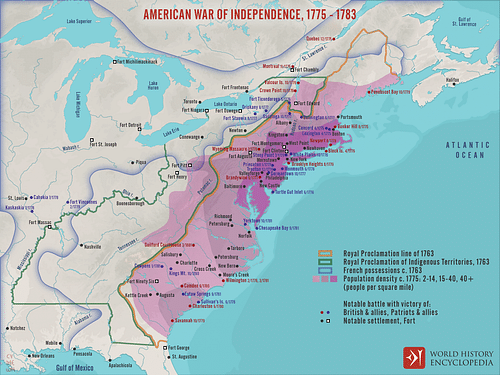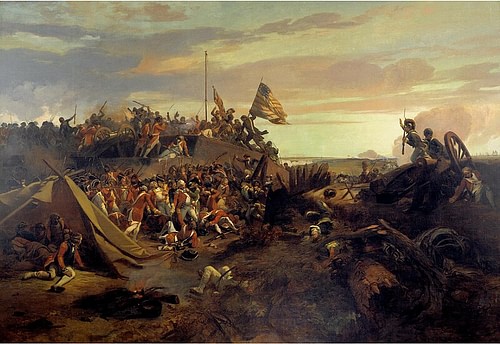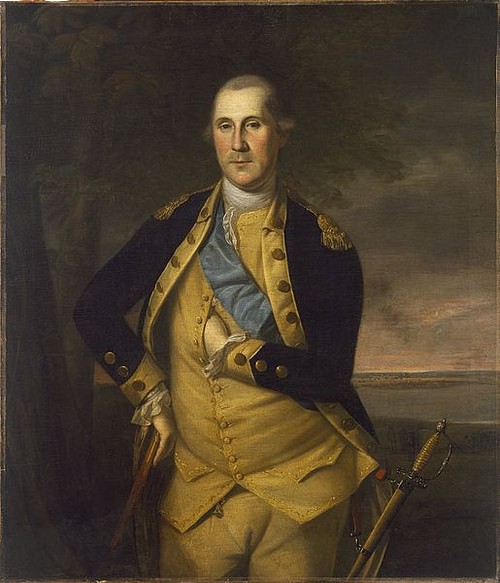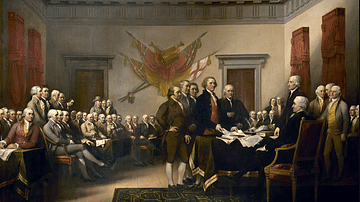
The American Revolutionary War (1775-1783), or the American War of Independence, was a conflict between Great Britain and its 13 North American colonies, who declared independence as the United States of America. Initially a rebellion within the British Empire, the war took on a global scope when France and Spain joined against the British, contributing to the eventual American victory.
War Begins
The war was the central part of a broader political upheaval, the American Revolution (c. 1765-1789), which had taken root over a decade before the first shots were fired. The quarrel between Britain and the Thirteen Colonies, over the issue of parliamentary taxes, steadily escalated, as colonists were divided into factions; the Whigs, or Patriots, opposed the taxes on the basis that they were unconstitutional, while the Tories, or Loyalists, remained in support of Great Britain. Tensions sometimes boiled over into acts of violence, such as the Boston Massacre (1770) and the Boston Tea Party (1773); a group of political agitators known as the Sons of Liberty was also known to assault Loyalists, tarring and feathering them.
In 1774, Parliament responded to the Boston Tea Party by issuing the so-called Intolerable Acts, which aimed to punish Boston by closing its harbor to commerce and suspending representative government in Massachusetts. In September 1774, 12 of the 13 colonies sent delegates to the First Continental Congress, where it was decided that the New England militias should begin preparing for a potential conflict with British soldiers. Amidst these rising tensions, General Thomas Gage, military governor of Massachusetts, knew that he could not crush a rebellion with the meager forces he had on hand and sought to suppress the New England militias before they had a chance to strike. He decided to achieve this by seizing stores of munitions that the militias had kept stockpiled in various towns.
Shortly after midnight on 19 April 1775, 700 elite British soldiers marched toward the town of Concord, where one such stockpile of weapons was stored. Despite Gage's attempts at discretion, the Patriots had discovered his intentions several days in advance; no sooner had the British troops set out than two Patriot riders, Paul Revere and William Dawes, were on their way to alert the militias. When the British soldiers reached the town of Lexington, on the road to Concord, they were confronted by 70 militiamen. After a brief standoff, a shot was fired; although it is unknown who fired it, it became immortalized as 'the shot heard round the world'. The British forces responded by firing two musket volleys, killing eight militiamen and wounding another ten.

After clearing the colonial militia off Lexington Green, the British continued on to Concord, where they encountered more resistance from 400 militiamen. After discovering that most of the munitions had already been removed by the Patriots, the soldiers began their 12-mile (19 km) retreat to Boston. The Patriots harassed them utilizing guerilla warfare, and by the end of the march, they had lost 273 casualties, compared to 95 Patriot losses. By then, the number of Patriots had swollen to 15,000 men. Encouraged by their victory in the Battles of Lexington and Concord, the Patriots laid siege to the 6,000 soldiers trapped inside Boston.
Washington Takes Command
Despite their numerical advantage, the Patriots lacked enough arms and ammunition to win the siege. Hoping to steal the artillery they needed from Fort Ticonderoga on Lake Champlain, the Patriots dispatched an expedition jointly led by Ethan Allen and Benedict Arnold to take the fort; on 10 May 1775, Allen and Arnold took the garrison by surprise and secured the capture of Fort Ticonderoga without spilling a drop of blood. Meanwhile, the Patriots outside Boston decided to lure the British army into an engagement by fortifying the provocative position atop Breed's Hill. The British had no choice but to launch a frontal assault; although the ensuing Battle of Bunker Hill (17 June 1775) was a British victory, it came at the horrendous price of 1,054 casualties.
By this point, the Second Continental Congress had taken on the role of wartime government of the rebellious colonies. It had adopted the New England army, which was now referred to as the Continental Army, and appointed George Washington to lead it. Washington arrived outside Boston in July 1775 and immediately set about strengthening discipline and reinforcing the military hierarchy. In autumn, he sent Colonel Henry Knox to retrieve the artillery from Ticonderoga. Arriving in November, Knox loaded the cannons onto 42 sleds and hauled them the hundreds of miles back to Boston. Washington positioned the guns on the heights overlooking the city. Rather than endure such a bombardment, the British forces evacuated Boston on 17 March 1776.
Darkest Hour
Emboldened by the Patriot performance in the Siege of Boston, Congress authorized the American invasion of Quebec, a British colony in Canada, hoping to coerce it into joining the rebellion. The Patriots captured Montreal and laid siege to the city of Quebec but suffered a crushing defeat at the Battle of Quebec (31 December 1775), where their commander, General Richard Montgomery, was killed. Demoralized and riddled with smallpox, the Patriots maintained a half-hearted siege of the city until the arrival of British reinforcements compelled them to withdraw.
In April 1776, Washington moved his army to New York City, predicting that its economic significance and strategic location would make it the next target of a British attack. He was right. In July, just as the United States was declaring its independence, British General William Howe arrived in New York Harbor with an army of 32,000 men, including British regulars as well as German auxiliary troops, commonly known as Hessians. On 22 August, Howe landed on Long Island and assaulted the American defenses atop Brooklyn Heights five days later. The Battle of Long Island resulted in another American defeat and the loss of 2,000 Continental troops.

Washington was forced to evacuate New York City, which came under British occupation on 15 September. Howe pursued Washington, fighting a string of battles at Harlem Heights (16 September), White Plains (28 October), and Fort Washington (16 November). The Continental Army was chased out of Manhattan, through New Jersey, and across the Delaware River; by December, its strength had dwindled to barely 3,000 ragged, disease-ridden men. Washington knew that the success of the revolution depended on the survival of his army, and so he adopted a Fabian strategy; he would avoid pitched battles, striking only when an opportunity presented itself.
Despite being on the cusp of victory, the British soldiers entered winter quarters, believing that the Continental Army were too weak to pose a threat. Washington was quick to act; on Christmas Day 1776, he led his army back across the Delaware River, surprising and defeating a Hessian garrison at the Battle of Trenton the next morning. He followed this up with a victory over the British rearguard at the Battle of Princeton (3 January 1777). These victories galvanized renewed support for the revolution and staved off defeat for at least another campaign season.
Year of the Hangman
Despite the setbacks at Trenton and Princeton, the new year of 1777 found the British confident of victory; indeed, Tories in New York City referred to it as 'the year of the hangman', as the triple sevens seemed to resemble the gallows from which the Patriots would soon swing. The British war minister, Lord Germain, had ordered General John Burgoyne to push south from Canada and advance along the Hudson River to capture Albany, New York, a move that would isolate New England from the other colonies. Germain expected General Howe to push northwards from Manhattan in support. Although he offered vague promises of assistance, Howe had no intention of playing second fiddle to Burgoyne. Instead, he planned his own campaign to capture the US capital of Philadelphia, a move that he believed would win the war.
Burgoyne's offensive, which began on 20 June, recaptured Fort Ticonderoga and defeated a Patriot force at Hubbardton (7 July), but as he penetrated deeper into the wilderness of upstate New York, he found that his supply lines were stretched dangerously thin. He sent a detachment of Germans to forage for supplies, only for the entire force to be wiped out by Patriot militia at Bennington (15 August). Still, Burgoyne's pride prevented him from turning back. He crossed over to the west side of the Hudson, only to come face to face with the Northern Department of the Continental Army near Saratoga, New York. Burgoyne fought the Patriots in two engagements collectively known as the Battles of Saratoga (19 September; 7 October) but was defeated both times. On 17 October, with no sign of help from Manhattan, Burgoyne surrendered his entire army, marking the greatest Patriot victory of the war thus far.

As Burgoyne was struggling in New York, Howe began his Philadelphia Campaign, landing in Maryland in late August. He defeated Washington twice, at the Battle of Brandywine (11 September) and the Battle of Germantown (4 October), but was unable to land a killing blow. He then occupied Philadelphia but failed to capture the Continental Congress, which had prudently evacuated the city. Although Howe had achieved his goal, the capture of Philadelphia did not have the desired effect, as the Patriot movement seemed no closer to collapsing. Frustrated, Howe blamed his lack of success on inadequate support from Parliament and resigned.
Meanwhile, the Continental Army had moved into winter quarters at Valley Forge, where it suffered from a lack of supplies, including food and clothing; around 2,000 soldiers died during the next six months from exposure, malnutrition, and disease. The army was saved when Washington garnered enough congressional support to reorganize the faulty supply department. The Continentals also underwent significant retraining at Valley Forge, under the careful guidance of professional soldiers like Baron Friedrich Wilhelm von Steuben.
Foreign Intervention
Since the outbreak of hostilities, France had been watching the war with interest. Eager to avenge its humiliating defeat in the recent Seven Years' War, France had been supplying the rebellious colonies with weapons and supplies; French officers, too, had been commissioned as major generals in the Continental Army, including the famous Marquis de Lafayette. The Saratoga Campaign convinced the French foreign minister, Comte de Vergennes, that the U.S. stood a chance at victory. In early 1778, Vergennes negotiated an alliance with the United States, and France officially entered the war, dispatching a fleet to North America in April.
In 1779, Spain entered the war as well, but only as a French ally; the Spanish wanted to weaken Britain but did not want to acknowledge the independence of the United States, fearing the effect it would have on their own colonies. The Dutch Republic, too, helped finance the Revolution and went to war with Britain in 1780. The entry of these European powers transformed a small, localized rebellion into a global conflict, stretching Britain's military forces thin; battles took place in the Caribbean, India, and even in Europe, where a Franco-Spanish army conducted the Great Siege of Gibraltar (1779-83).

Stalemate in the North
In May 1778, the British army evacuated Philadelphia. Howe's replacement, Sir Henry Clinton, had been ordered to consolidate his forces in New York City to brace for a possible French attack there. Washington pursued, striking at the Battle of Monmouth (28 June), which greatly raised Patriot morale, as the Continentals held their ground for five hours in the scorching heat. The British army then withdrew to the safety of New York City, with the Continental Army taking up a position just outside the city. The two armies would maintain these approximate positions for the next three years.
In the summer of 1778, the French fleet arrived off the American coastline. The French admiral, Comte d'Estaing, agreed to help the American general John Sullivan assault the British-occupied city of Newport, Rhode Island. However, after the French ships were battered in a storm, d'Estaing opted to sail for Boston for repairs, leaving Sullivan's army on its own at the Battle of Rhode Island (29 August 1778). The next year saw limited action in the North, although the Americans did capture key British positions at Stony Point and Paulus Hook. Washington took advantage of the quiet to send General Sullivan on a punitive expedition against those Iroquois nations that had allied with the British. Sullivan's expedition destroyed over 40 Iroquois villages in upstate New York and burned over 160,000 bushels of corn, greatly reducing the political power of the Iroquois Confederacy.
The Continental Army spent the winter of 1779-80 at Morristown, New Jersey, where it experienced an even harsher winter than at Valley Forge. Rapid depreciation of the Continental currency meant that Congress could not pay the soldiers what they were owed, leading several Continental regiments to mutiny in early 1781. Hoping to capitalize on the tensions in the Continental Army, German General Wilhelm von Knyphausen launched an attack on New Jersey but was repulsed at the battles of Connecticut Farms (7 June 1780) and Springfield (23 June). In September 1780, the capture of British Major John André revealed that Benedict Arnold had become disillusioned with the Patriot cause and had plotted to sell the stronghold of West Point to the British army. Arnold escaped capture and defected to the British side, while his contact, Major André, was hanged as a spy.
Southern Campaigns
As fighting petered out in the North, the British generals shifted their focus to the American South, partially because the South was rumored to be replete with Loyalists, who would welcome the British army with open arms. Another reason was that the South provided the U.S. with much of its cash crops, including rice, indigo, and tobacco, the loss of which would be a major blow to the American war effort. In December 1778, as part of their 'southern strategy', the British army captured the lightly defended Savannah, Georgia. The following year, a Franco-American army failed to retake the city at the Siege of Savannah, making Georgia the first state to fall back under British control.
Emboldened by this success, General Clinton launched a larger expedition against Charleston, South Carolina, the most important city in the South. The Siege of Charleston was arguably the greatest British victory of the war; Clinton not only captured Charleston itself but took prisoner the entire Southern Department of the Continental Army. Satisfied with his victory, Clinton returned to Manhattan, leaving his second-in-command, Lord Charles Cornwallis, behind to pacify the rest of South Carolina.
This proved easier said than done. Although Cornwallis won a major victory over a hastily assembled American army at the Battle of Camden (16 August 1780), the residents of South Carolina proved much less Loyalist than he would have liked. Several Patriot militias began springing up in the Carolinian backcountry, led by cunning men like Thomas Sumter, Francis Marion, and Andrew Pickens; utilizing their knowledge of the land, these militias would strike at parties of British soldiers before melting back into the woodlands and swamps. Cornwallis attempted to beat the Patriots at their own game by raising Tory militias, sparking a bloody South Carolinian civil war. But the strength of these Tory militias was broken at the Battle of Kings Mountain (7 October 1780).
After the British suffered another defeat at the Battle of Cowpens (17 January 1781), a frustrated Cornwallis decided to march into North Carolina to deal with a Continental Army under General Nathanael Greene, which was providing aid to the South Carolina militias. Cornwallis caught up with Greene at the Battle of Guilford Court House (17 March 1781), winning a pyrrhic victory; Greene, following Washington's example, managed to slip away with his army intact, depriving Cornwallis of a decisive victory. Rather than chase Greene across the Carolinas, Cornwallis decided to press on into Virginia, hoping that his suppression of that state would end Patriot resistance throughout the South. Greene, meanwhile, confronted the forces Cornwallis had left behind in the Carolinas, fighting battles at Hobkirk's Hill (25 April) and Eutaw Springs (8 September).
Yorktown & Paris
As soon as Cornwallis invaded Virginia, he was reprimanded by General Clinton; under the false impression that Washington was preparing to attack New York City, Clinton ordered Cornwallis to return to Manhattan. The exasperated Cornwallis marched his army to the port town of Yorktown, fortifying it as he awaited the Royal Navy to pick him up. The Patriots sensed a perfect opportunity; a small force under Marquis de Lafayette was sent to keep Cornwallis trapped in Yorktown, while Washington led a combined Franco-American force south. Meanwhile, a French fleet under Comte de Grasse defeated a British fleet at the Battle of the Chesapeake (5 September), cutting off Cornwallis' escape by sea. Washington's allied army commenced the Siege of Yorktown, which ended with Cornwallis' surrender on 19 October 1781.

With the American victory at Yorktown, the active phase of the war came to an end. Parliament had, by now, grown war-weary; the ministry of Lord North, which had conducted the war, was ousted, and the new ministry offered to negotiate peace. The resultant Treaty of Paris of 1783 brought an end to the war; Great Britain recognized the independence of the United States, whose borders were fixed at the Mississippi River. Washington and the new British commander-in-chief, Sir Guy Carleton, negotiated a ceasefire as the peace negotiations were underway, and the last British troops evacuated New York City in November 1783. The war was finally over, leaving the infant United States to figure out what kind of nation it was going to become.










